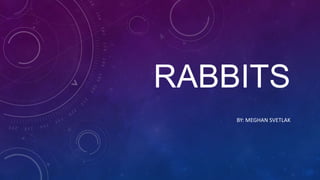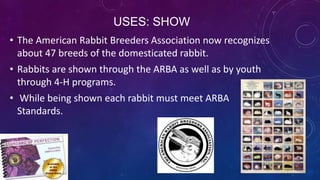Ms rabbits bio_div
- 2. WILD RABBITS VS. DOMESTICATED RABBITS
- 3. THE WILD RABBIT âĒ Scientific name: Sylvilagus floridanus âĒ Life span: up to 2-3 years. âĒ Length: 15 to 18 inches âĒ Weight: between 2-4 pounds âĒ Color: ranges from the many shades of brown and gray âĒ Uses: hunting and for wild life
- 4. THE DOMESTICATED RABBITOryctolagus cuniculus âĒ Scientific Name: âĒ Lifespan: 8-10 years in captivity âĒ Length: 8 inches â 36 inches âĒ Weight: between 2-15 pounds âĒ Color: Many colors and variations ( Solid or Broken; Blue, Black, Blue, Castor, Chocolate, Opal, Silver, Tan, Ect.) âĒ Uses: Show, Pets, Meat, Fur
- 5. USES: SHOW âĒ The American Rabbit Breeders Association now recognizes about 47 breeds of the domesticated rabbit. âĒ Rabbits are shown through the ARBA as well as by youth through 4-H programs. âĒ While being shown each rabbit must meet ARBA Standards.
- 6. USES: PETS âĒ Most of us may know rabbits just as pets. âĒ Many are bought from pet stores and are mixed breeds from the many recognized by the ARBA. âĒ (You can also show a mixed rabbit in 4-H programs.)
- 7. USES: MEAT âĒ There are a few types of rabbits that are raised for meat. âĒ The breeds include: The New Zealand White, Californian, American, Chinchillas, CrÃĻme & Champagne D Argentâs.
- 8. USES: FUR âĒ Many wool rabbits are raised for their fur.
- 9. WILD VS. DOMESTICATED: RAISING THEIR YOUNG âĒ Rabbits in the wild are born in burrows inside of nests. They may not even be in burrows but out in the open. Domesticated Rabbits are born inside of a nesting box where the mother will build her nest inside.









